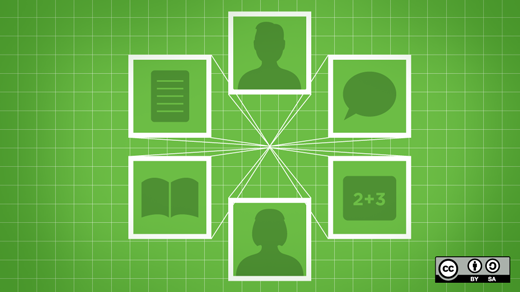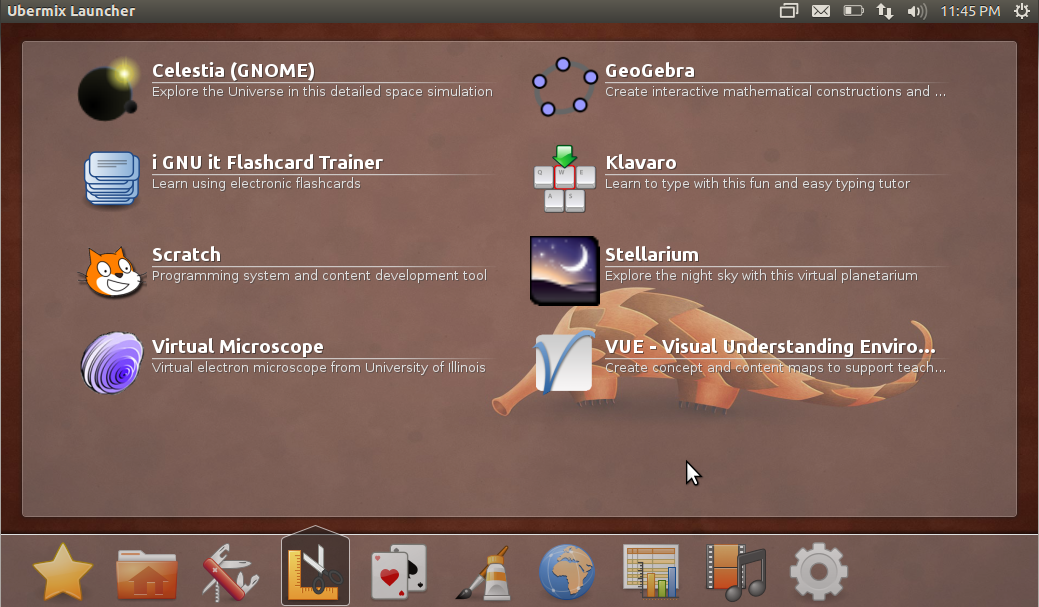How are we going to teach the next generation about open source and Linux? More importantly, how can we get the right technology into classrooms to empower our educators to teach our children the open source way?
The opportunities that open source presents to education and academics is growing each day. Opensource.com highlights individual tools like Scratch and TuxPaint that are starting to make an impact—but, what about an entire education distribution? How do we make it easier to get an entire toolset into the hands of school systems, teachers, and students? How can we really move the needle and present a revolutionary open source operating system designed for kids and education?
Enter Ubermix.
Ubermix is a Linux distribution built by educators, for educators, and for students, "with an eye towards student and teacher empowerment." That's why the "desktop" looks like a mobile phone. And it comes pre-installed with tons of open source applications that are geared toward education and creativity.
We caught up with the founder of Ubermix, Jim Klein, to find out more about this Linux-based operating system and how the project aims to create a turn-key installation process, reducing the complexity and deployment often associated with installing a Linux distro. We also wanted to hear some of the stories from the people already finding success with Ubermix.
Takeaway sneak peek: You can make a difference for the next generation. Just tell someone you know in education about Ubermix.
Tell our readers about Ubermix and your target audience.
Ubermix is designed to bring the power and flexibility of free software and an open operating system to kids and the education community. While there are a number of general purpose Linux builds out there, few have made significant inroads into schools, due in large part to their complexity and general purpose design language. What Ubermix brings is an easy entry point and sensible design decisions, having been assembled with a real understanding of the challenges education technologists face when attempting to implement something new. Features such as a five minute install from a USB key, extraordinary hardware compatibility, and a quick, 20-second reset process make it possible for understaffed and underfunded school technology teams to scale up significant technology access without increasing the need for technical support.
For kids, Ubermix brings a far more approachable interface to Linux, virtually eliminating the traditional "desktop" paradigms in favor of something similar to a cell phone that's far easier to use. Couple that with more than 50 carefully selected applications across a broad array of subject areas and that quick reset function, which enables a student to solve their own problems without losing any of their work, and you have a powerful tool for learning.
What are some of the open source applications included with Ubermix?
Ubermix comes pre-loaded with a number of applications for education, productivity, design, programming, Internet, and multimedia construction. Education oriented applications like Celestia, Stellarium, Scratch, VirtualLab Microscope, Geogebra, iGNUit, and Klavaro, as well as educational games like TuxMath, TuxTyping, gMult, and Numpty Physics all bring with them plenty of opportunities to learn.
Internet applications we all know and love, like Firefox, Thunderbird, Chrome, Google Earth, and Skype are all there. Common productivity apps like LibreOffice, NitroTasks, Planner Project Management, VYM (View Your Mind), and Zim Desktop Wiki are too. Kids interested in design will find the GIMP, Inkscape, Scribus, Dia, Agave, and even TuxPaint for the younger ones. And apps like Audacity, Openshot, Pencil, and ffDiaporama help round out the media offerings. These, and many more, make Ubermix a powerful launchpad for student creativity and learning.
What does the future hold for Ubermix?
I'm constantly amazed and humbled by the growth of Ubermix, and continue to work towards making it better, easier, and more powerful for kids, teachers, and technologists. I think touch will certainly play a role in the future, as will alternative devices and form factors. It will be interesting to see just how the recent hardware renaissance plays out, and where Ubermix fits into the future needs of schools. I also plan to work with the community to build some sort of a web-based management interface that would make larger deployments even easier to manage.
What is the most interesting way Ubermix has been used so far?
People always find ways to do amazing things with Ubermix. A team of middle-school students have built a number of computer labs in the central valley using government surplus machines. Kramden Institute is planning to deploy Ubermix on 3000 computers given to needy kids to help bridge the digital divide.
A retired education technology leader is not only building and donating Ubermix machines to needy families, but is also touring the country, sharing Ubermix at conferences in several states. And I once heard from an activist who shared with me that he was giving Ubermix netbooks to kids in Central America. It's truly amazing and inspiring.
Where does someone get started with Ubermix and how can someone get involved?
You can find all things Ubermix at ubermix.org. As with any open source project, the bigger the community the better! New ideas and code are always welcome, as are translators, writers for the wiki, and anyone willing to help out answering questions in the forums. And, of course, help spreading the word!
Bonus: What's the best "feel good" story from the Ubermix community?
The best thing about Ubermix is seeing an empowered student do something amazing with it and then share how they did it, both within their classroom and school, and the online world. From that geeky kid who struggled with relationships until his peers found out what he could do with a computer... to the special day class kids who get to shine as they teach the regular ed kids how to build something... to the teams of fourth graders writing apps and deconstructing code... to the creative, outgoing kid who makes and makes and makes things that he shares online. It's always incredible to behold.
It's the power of community driven by open source, writ large for the world to see.







9 Comments